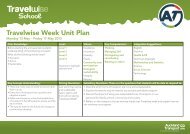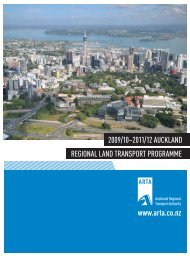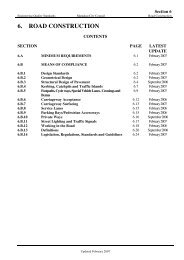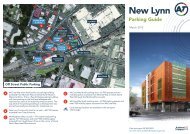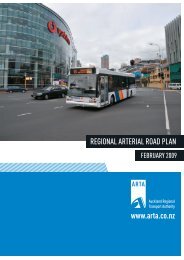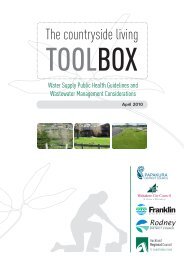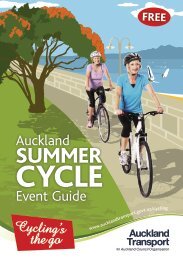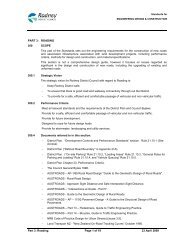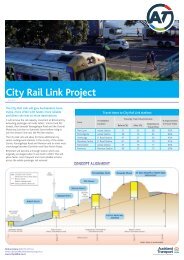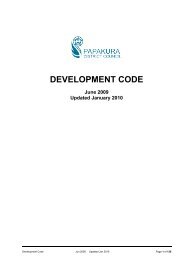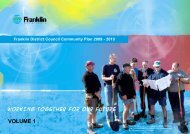The UTP Research Report - Auckland Transport
The UTP Research Report - Auckland Transport
The UTP Research Report - Auckland Transport
You also want an ePaper? Increase the reach of your titles
YUMPU automatically turns print PDFs into web optimized ePapers that Google loves.
<strong>The</strong> Universities' Travel Plan<br />
A TravelWise project for the Learning Quarter<br />
<strong>Research</strong> <strong>Report</strong> – September 2007
Table of Contents<br />
WORKING TOGETHER ............................................................................................................2<br />
EXECUTIVE SUMMARY ...........................................................................................................3<br />
1. INTRODUCTION ..................................................................................................................4<br />
1.1 Planning for the future .................................................................................................4<br />
1.2 TravelWise ...................................................................................................................5<br />
1.3 <strong>The</strong> Universities’ Travel Plan so far .................................................................................5<br />
1.4 Focus on research .........................................................................................................6<br />
2. RESEARCH RESULTS – KEY ISSUES .....................................................................................7<br />
2.1 Perceptions of travel .....................................................................................................7<br />
2.1.1 Student perception of travel options ...........................................................................7<br />
2.1.2 Staff perception of travel options ...............................................................................8<br />
2.2 Accessibility of travel options ........................................................................................9<br />
2.2.1 Walking ....................................................................................................................9<br />
2.2.2 Cycling .....................................................................................................................9<br />
2.2.3 Passenger transport .................................................................................................10<br />
2.3 Future Planning workshops .........................................................................................11<br />
2.4 Student travel behaviour .............................................................................................12<br />
2.4.1 Changing behaviours ...............................................................................................12<br />
2.4.2 Flexible travel arrangements .....................................................................................13<br />
2.4.3 How students are travelling around ..........................................................................13<br />
2.4.4 Travel choice and distance ........................................................................................13<br />
2.4.5 Travel options and student demographics .................................................................14<br />
2.4.6 Parking ...................................................................................................................14<br />
2.4.7 Likelihood for behaviour change ..............................................................................14<br />
2.4.8 Trip conversions .......................................................................................................15<br />
2.5 AUT University staff travel behaviour ...........................................................................16<br />
2.5.1 Travel characteristics ................................................................................................16<br />
2.5.2 How staff are travelling around ................................................................................16<br />
2.5.3 Travel choice and distance ........................................................................................17<br />
2.5.4 Parking ...................................................................................................................17<br />
2.5.5 Likelihood for behaviour change ..............................................................................17<br />
2.5.6 Trip conversions .......................................................................................................18<br />
3. DEVELOPING TRAVEL PLAN ACTIONS ..............................................................................19<br />
4. A SUMMARY OF TRAVEL PLAN ACTIONS ........................................................................20<br />
5. MOVING FORWARD .........................................................................................................24<br />
1
Working together<br />
<strong>The</strong> <strong>Auckland</strong> Regional <strong>Transport</strong> Authority (ARTA) has teamed up<br />
with <strong>The</strong> University of <strong>Auckland</strong>, AUT University, <strong>Auckland</strong> City<br />
Council and Transit New Zealand to ensure that access to the Learning<br />
Quarter precinct in <strong>Auckland</strong>’s CBD remains a priority now and in the<br />
future. <strong>The</strong> Universities’ Travel Plan <strong>Research</strong> <strong>Report</strong> was prepared<br />
by the <strong>Auckland</strong> Regional <strong>Transport</strong> Authority on behalf of<br />
the Universities’ Travel Plan Steering Group.<br />
2
Executive summary<br />
<strong>The</strong> Universities’ Travel Plan represents an agreement between<br />
<strong>The</strong> University of <strong>Auckland</strong>, AUT University, the <strong>Auckland</strong> Regional<br />
<strong>Transport</strong> Authority (ARTA), <strong>Auckland</strong> City Council and Transit New<br />
Zealand to develop a series of actions that will increase travel choices<br />
for the 40,000 students and staff who travel to and around <strong>The</strong><br />
University of <strong>Auckland</strong> and AUT University city campuses each day.<br />
As <strong>Auckland</strong> grows and the Learning Quarter continues to develop,<br />
we need to ensure that our excellent universities have excellent<br />
transport links. <strong>The</strong> Universities’ Travel Plan will help to achieve this<br />
goal. It is a 10-year plan that considers all travel options including<br />
walking, cycling, passenger transport, carpooling and driving.<br />
Since the start of the project in June 2005, the Universities’ Travel<br />
Plan has followed ARTA’s TravelWise planning process. <strong>The</strong> key parties<br />
involved in the project carried out a comprehensive research and<br />
development programme which looked at how, and why, people<br />
travel to the Learning Quarter in the way they do. <strong>The</strong> research<br />
involved the collection and analysis of a vast amount of information<br />
from a total of around 6,500 people, which makes it the largest<br />
travel behaviour research programme so far undertaken in New<br />
Zealand.<br />
<strong>The</strong> research findings indicate that university students and staff are<br />
generally already very high users of sustainable transport (walking,<br />
cycling and using passenger transport), setting an example to the rest<br />
of the CBD’s commuters. While students are particularly flexible in<br />
their current travel behaviour, frequently using a combination of<br />
travel options during the week, they often have strong aspirations<br />
towards car ownership.<br />
Both students and staff are more likely to drive the longer they are at<br />
university; however they expressed a strong willingness to consider<br />
other travel options.<br />
On the whole, the research showed that student and staff travel<br />
choices are determined by a combination of factors including finances,<br />
course structure/teaching requirements, student employment or other<br />
commitments, perceptions of service quality and value for money,<br />
access to information and knowledge of service availability.<br />
When considering other travel options, both staff and students<br />
stated that they would most likely use passenger transport options<br />
more often, followed by an increase in carpooling, walking<br />
and cycling.<br />
Based on these findings, a number of recommendations were<br />
developed, and consulted on by university staff and students. <strong>The</strong><br />
feedback from the consultation phase was then used to finalise the<br />
Universities’ Travel Plan and develop travel plan actions.<br />
<strong>The</strong> project parties have set an initial target of encouraging<br />
10 per cent of current car drivers to travel by more sustainable<br />
options. This will be achieved through improvements in infrastructure,<br />
services, facilities and information – making these options safer, more<br />
convenient and better value for money.<br />
This report summarises the research and presents the travel plan<br />
actions that will make it easier for people to get to and around the<br />
Learning Quarter.<br />
3
1. Introduction<br />
Each day, during semester time, around 40,000 students and staff<br />
travel to and around <strong>The</strong> University of <strong>Auckland</strong> and AUT University<br />
city campuses, an area also known as the Learning Quarter. <strong>The</strong> size<br />
of this travelling population and the central location of the Learning<br />
Quarter mean that this daily journey puts significant pressure on<br />
<strong>Auckland</strong> City roads and passenger transport systems. This can mean<br />
congestion and delayed journey times for both students and staff,<br />
and many other commuters, as they travel in and around the CBD.<br />
In order to maintain <strong>Auckland</strong>’s status as an excellent place to live<br />
and learn we need to ensure that access to education remains a<br />
priority both now and in the future.<br />
To achieve this goal, <strong>The</strong> <strong>Auckland</strong> Regional <strong>Transport</strong> Authority<br />
(ARTA) has joined with <strong>The</strong> University of <strong>Auckland</strong>, AUT University,<br />
<strong>Auckland</strong> City Council and Transit New Zealand to develop the<br />
Universities’ Travel Plan. This represents an agreement to work<br />
together to develop an agreed series of actions that will increase<br />
travel choices and make it easier for more people to get to and<br />
around the Learning Quarter.<br />
This report outlines the research results that have led to the<br />
development of the Universities’ Travel Plan, and includes a range of<br />
actions that will make travel around the Learning Quarter easier.<br />
1.1 Planning for the future<br />
<strong>Auckland</strong> faces a number of changes over the next 10 years, as we<br />
grow to support an increasing population. <strong>The</strong>se include new building<br />
developments and facilities across the city as well as major changes<br />
to our transport infrastructure and services. Add to this the changing<br />
costs of fuel and accommodation and we can start to appreciate the<br />
wide range of factors that affects where we live and how we travel.<br />
Figure 1 – Map of the Learning Quarter<br />
By taking account of regional and local plans, the Universities’ Travel<br />
Plan has developed recommendations to accommodate these<br />
changes over the next 10 years and beyond.<br />
4
1.2 TravelWise<br />
<strong>The</strong> Universities’ Travel Plan is part of the TravelWise programme,<br />
which has been developed by ARTA. It follows an internationally<br />
recognised process that makes travel to schools and workplaces<br />
across <strong>Auckland</strong> easier 1 . Like all travel plans, the Universities’ Travel<br />
Plan looks at all travel options including walking, cycling, passenger<br />
transport, carpooling and driving.<br />
When thinking about the needs of staff and students, university<br />
travel plans represent some particular challenges and opportunities,<br />
including:<br />
• People travel to university for many different reasons (e.g. work,<br />
study, sport, recreation and social events)<br />
1.3 <strong>The</strong> Universities’ Travel Plan so far<br />
<strong>The</strong> Universities’ Travel Plan (<strong>UTP</strong>) was started in 2005, when an<br />
agreement was made between the key organisations involved in this<br />
project. Since that time, the group has carried out a comprehensive<br />
research and development programme which looked at how, and<br />
why, people travel to the Learning Quarter in the way they do. This<br />
research is the largest travel behaviour research programme so far<br />
undertaken in New Zealand. Based on the research findings, a<br />
number of recommendations were developed, which were then<br />
consulted on by university staff and students. <strong>The</strong> feedback from the<br />
consultation phase was then used to finalise the Universities’ Travel<br />
Plan and develop travel plan actions. Table 1 (below) shows an outline<br />
of the Universities’ Travel Plan project phases.<br />
• <strong>The</strong> number of travellers changes across the year during and<br />
between semesters, which can have a substantial overall impact<br />
on local and regional congestion<br />
• Students and staff tend to have very different travel patterns<br />
• <strong>The</strong>ir travel choices can be motivated by a wide variety<br />
of factors<br />
• Staff and students need different facilities.<br />
Phase Description Timing<br />
1 Set-up During this phase, the key organisations involved in the project developed an<br />
agreement to focus on the CBD’s Learning Quarter. <strong>The</strong>y also agreed on a<br />
project framework, as well as on roles and responsibilities.<br />
2 a) <strong>Research</strong> and<br />
development<br />
b) Developing<br />
recommendations<br />
An integrated research programme was developed, which collected a range<br />
of information relating to staff and student travel behaviour and perceptions<br />
of travel options.<br />
After the data analysis was completed, a range of recommended actions was<br />
drafted in the areas of infrastructure and services, facilities, marketing and<br />
information provision.<br />
c) Consultation <strong>The</strong> research results and recommended actions were circulated to university<br />
students and staff, as well as a number of travel planning professionals.<br />
Workshops were held at the universities to find ways in which students<br />
and staff can contribute to the Universities’ Travel Plan’s finalisation and<br />
ongoing implementation.<br />
3 Plan finalisation During this phase, the Universities’ Travel Plan was completed and the<br />
travel plan actions were finalised, using the feedback received during the<br />
consultation period.<br />
Jul 05<br />
Jul 05-Mar 06<br />
Mar 06-Nov 06<br />
Dec 06-Mar 07<br />
Mar 07-Aug 07<br />
4 Implementation <strong>The</strong> agreed travel plan actions are being implemented. Sep 07 onwards<br />
5 Completion Ongoing management of the travel plan will take place to ensure the<br />
travel plan actions are integrated into the universities’ processes.<br />
6 Continuous improvement Staff and student travel behaviour will be monitored and a review of the<br />
Universities’ Travel Plan’s evaluation survey will be undertaken.<br />
Table 1 – <strong>UTP</strong> project phases<br />
24-month cycle<br />
1<br />
<strong>The</strong> TravelWise process is outlined at www.travelwise.org.nz<br />
5
1.4 Focus on research<br />
Understanding travel patterns – how, why, when and where people<br />
travel from – is central to the development of any travel plan. Given<br />
the number of people who travel to the Learning Quarter and the<br />
fact that staff and students have very different travel patterns,<br />
a comprehensive research programme was developed in order to<br />
find out as much information as possible. <strong>The</strong> research phase is<br />
outlined in Box 1 (below).<br />
Perceptions of travel<br />
Interactive displays and<br />
workshops with students<br />
and staff<br />
Travel access study<br />
Infrastructure, safety and<br />
service review of the<br />
Learning Quarter<br />
Future Planning workshops<br />
Strategic review of local and regional plans that affect the<br />
Learning Quarter for the next 10 years, leading to the<br />
identification of key issues and drafting of key principles<br />
Understanding travel behaviour<br />
<strong>The</strong> TravelWise survey to students and staff enabled a detailed<br />
review of current travel behaviour and tested some of the key<br />
issues that arose from the future planning workshops<br />
Development of recommended actions<br />
Analysis of the research results has led to the drafting of<br />
prioritised actions. <strong>The</strong>se were then further reviewed by the<br />
universities, ARTA, <strong>Auckland</strong> City and Transit NZ<br />
Consultation on recommended actions<br />
Box 1 – <strong>Research</strong> and development phase<br />
6
2. <strong>Research</strong> results – Key issues<br />
In general, the research has shown a dramatic shift in travel options<br />
in recent years 2 – particularly amongst students – with increasing<br />
numbers travelling by passenger transport or carpooling. <strong>The</strong> research<br />
suggests that this change in behaviour is largely a reaction to<br />
increases in fuel and parking costs, and a lack of available parking.<br />
Improvements in passenger transport infrastructure and services have<br />
also contributed to this shift.<br />
Several key issues arising from the research have helped in<br />
developing and prioritising recommendations 3 . <strong>The</strong>se issues are<br />
highlighted below.<br />
2.1 Perceptions of travel<br />
A number of different methods was used to find out how students<br />
and staff felt about transport options, including workshops,<br />
interviews and photo-novellas 4 .<br />
Overall, the findings suggest that there is a wide range of issues that<br />
could be improved to make travel easier. <strong>The</strong>se include improvements<br />
to infrastructure, services and the relative cost of passenger transport,<br />
and a better flow of information. <strong>The</strong>re is also a strong suggestion<br />
that passenger transport could be more effectively marketed to<br />
improve its perceived value. <strong>The</strong> findings are outlined in more<br />
detail below.<br />
2.1.1 Student perception of travel options<br />
Overall, the research found that students highly rate driving, feeling<br />
that car ownership brings a sense of freedom and status, and is<br />
essential for a socially active lifestyle. Owning a car is an aspiration<br />
for many. However, some students have philosophical objections to<br />
car travel – mainly for environmental and health reasons.<br />
Unsurprisingly therefore, while some students are committed to<br />
passenger transport, most students’ feelings about passenger<br />
transport range from lukewarm to very negative. <strong>The</strong>se feelings are<br />
often based on the perception that passenger transport is too<br />
expensive for the service it delivers, unreliable and less convenient<br />
than travelling by car 5 .<br />
Despite their perception of passenger transport, students’ actual<br />
transport choices were often determined by more functional factors,<br />
often outside of their control, including:<br />
• <strong>The</strong> travel options that are accessible from their place of<br />
residence<br />
• <strong>The</strong> cost of car travel compared with the cost of passenger<br />
transport<br />
• Other responsibilities (work, family and study) that create a need<br />
to be flexible<br />
• Access to information about travel options and costs.<br />
<strong>The</strong>se factors lead many students to make choices that they would<br />
not otherwise make. Table 2 (below) classifies students according to<br />
the feelings they have about their travel options.<br />
While these are very broad groups, they do provide some insight into<br />
how and why students make travel decisions and the kinds of things<br />
that can be done to make travel easier. <strong>The</strong> classifications also suggest<br />
that there are opportunities to increase passenger transport use<br />
amongst some groups (for example the ‘cost-conscious drivers’), and<br />
improve services and customer information to give ‘passenger<br />
transport captives’ better value for their money.<br />
Passenger transport captives<br />
Car lovers<br />
Cost-conscious car drivers<br />
Car captives<br />
Sustainable travellers<br />
Many students would rather drive to university but cannot afford a car. <strong>The</strong>y therefore feel they<br />
have little option but to take the bus or train.<br />
Others who own a car, love the status and freedom it gives them and will drive it to university<br />
regardless of cost.<br />
Many drivers feel that car ownership comes with a high cost for fuel and parking, and will consider<br />
other cost-effective options.<br />
Some students feel that owning a car is a burden but, now that they have one, they really should<br />
use it.<br />
This group actively makes decisions on where they live so that they have access to passenger<br />
transport, or can walk or cycle to university.<br />
Table 2 – Student perception of travel options<br />
2<br />
Compared with the 2002 <strong>Transport</strong>ation and Parking Study.<br />
3<br />
Full copies of the Travel Access <strong>Report</strong> and the TravelWise Survey Results are available from the <strong>Auckland</strong> Regional <strong>Transport</strong> Authority.<br />
4<br />
In total, 32 students where involved in workshops and interviews, with another 300 taking part in an interactive exhibition.<br />
5<br />
<strong>The</strong>se findings are strengthened by those presented in a separate ARTA study, Segmenting the <strong>Auckland</strong> <strong>Transport</strong> System 2006.<br />
7
2.1.2 Staff perception of travel options<br />
Ten staff members from the two universities were interviewed to find<br />
out what affected their travel behaviour. <strong>The</strong> following key issues<br />
were raised:<br />
• Staff generally reported a tendency to live outside of the<br />
CBD. While some said they were living close to passenger<br />
transport services for philosophical reasons, the majority did<br />
not consider the effects on travel options when choosing their<br />
home location.<br />
• Staff have less need to be flexible than students, as they tend to<br />
work to a more regular commuting timetable.<br />
• Some staff reported that family and other commitments<br />
influenced their travel options, feeling that passenger transport<br />
did not give them the reliability or flexibility they needed.<br />
• Access to staff car parks at both universities, and the subsidised<br />
cost associated with the car parks, significantly influenced staff<br />
members’ decision to travel by car. New staff, without parking<br />
licences or permits, could face a long waiting period (of up<br />
to three years) and therefore were more likely to use<br />
passenger transport.<br />
• Staff tended to be aware of, and express concern over,<br />
environmental and health issues related to travel options. In<br />
practice, however, only a few staff reported making decisions<br />
based on these concerns.<br />
Overall, staff reported the following perceived advantages and<br />
disadvantages when thinking about passenger transport, driving,<br />
walking and cycling (see Table 3).<br />
Passenger transport<br />
Car travel<br />
Walking and cycling<br />
Advantages<br />
• Fast travel on trains<br />
• Time to relax before and after work<br />
• Time to do other things<br />
• Time saving<br />
• Costs of driving and parking considered to be<br />
comparable with (or even cheaper than)<br />
passenger transport<br />
• Cheap parking at universities<br />
• Flexible<br />
• Healthy activity<br />
• Sense of making a contribution<br />
Disadvantages<br />
• Indirect bus routes take more time<br />
• Time delays in congested traffic and during<br />
ticket transactions<br />
• Inconvenient stop and station locations<br />
• Lack of information on services and costs<br />
• Uncomfortable atmosphere, poor relationship<br />
between passengers and drivers<br />
• Poor quality of vehicles<br />
• Uncomfortable seating<br />
• Timetable issues, reliability and inappropriate timing<br />
of some services<br />
• Need to leave early to avoid peak travel<br />
• Stress related to driving<br />
• Time wasted finding a car park<br />
• Poorly maintained footpaths<br />
• Lack of safe pedestrian crossings<br />
• Serious safety issues for pedestrians and cyclists<br />
• Lack of cycle paths and prioritisation; sharing lanes<br />
with buses is unsafe<br />
• Lack of lockers and showers, poor promotion,<br />
accessibility of existing lockers and showers<br />
• Inappropriate, poorly located cycle parking facilities<br />
• Unaware and inconsiderate drivers<br />
Table 3 – Staff perception of transport options<br />
8
2.2 Accessibility of travel options<br />
To assess the Learning Quarter’s accessibility by walking, cycling,<br />
passenger transport and vehicles, a <strong>Transport</strong> Access Study was<br />
undertaken. <strong>The</strong> study identified specific areas of concern, particularly<br />
around safety, prioritisation and access to facilities and services.<br />
2.2.1 Walking<br />
Walking is the most important means of getting around within the<br />
Learning Quarter, as all travellers will eventually travel along<br />
pedestrian routes whichever way they arrived. Moreover, because of<br />
the location of the universities, each person is likely to have to cross<br />
a major road at least once and possibly many times in a day 6 .<br />
Development of <strong>The</strong> University of <strong>Auckland</strong> Business School will<br />
significantly increase the number of pedestrians crossing Symonds<br />
Street, which currently has around 24,000 vehicles travelling down it<br />
each day. <strong>The</strong> safety of pedestrians is therefore identified as a top<br />
priority. (Data on reported crashes involving pedestrians can be seen<br />
in Figure 2 below.)<br />
2.2.2 Cycling<br />
<strong>The</strong> central location of the Learning Quarter means that many<br />
residential areas are within a 20-minute cycle ride. While <strong>Auckland</strong>’s<br />
topography is a factor, safety issues are of greatest concern when<br />
considering how to make it easier for more people to travel by bike.<br />
Currently, around 210 cyclists travel down Symonds Street during the<br />
morning peak and a further 200 travel down Queen Street. <strong>The</strong><br />
access study shows that this is not a journey for the faint-hearted, as<br />
cyclists compete with a high volume of traffic, often have to ride over<br />
uneven and obstructed surfaces and lack of effective prioritisation at<br />
traffic lights and intersections. Provision of and access to appropriate<br />
facilities including showers, lockers and parking is also identified as a<br />
key issue.<br />
<strong>The</strong> steep gradients of some of the roads can discourage walking<br />
and they are particularly hard for people with impaired mobility. <strong>The</strong><br />
study identified that some key routes to and around the Learning<br />
Quarter have gradients that are more than 1:12, greater than the<br />
maximum considered acceptable for wheelchair users and mobilityimpaired<br />
pedestrians.<br />
Figure 2 – <strong>Report</strong>ed crashes involving pedestrians<br />
(for the five years to June 2005)<br />
6<br />
N. Harre and T. Milfont (2004). Pedestrian safety on Symonds Street – November 2004.<br />
9
2.2.3 Passenger transport<br />
<strong>The</strong> study found that the Learning Quarter is very well served by<br />
buses, with 1,700 buses using Symonds Street and a further 780<br />
using Queen Street each day. With a few notable exceptions, most<br />
areas of <strong>Auckland</strong> are accessible from bus stops within 400 metres of<br />
the two campuses.<br />
While the distance and gradient to the ferry terminals and Britomart<br />
station may be a deterrent, these transport hubs are also well served<br />
by buses to and from the Learning Quarter. Services aside, a full<br />
review of bus stop facilities in the area has revealed opportunities for<br />
improvements, which are summarised in Table 4 7 .<br />
Walking safety<br />
• Footpath condition and obstructions<br />
• Prioritising pedestrians over traffic<br />
• Left slip lane hazards<br />
• Traffic speed control<br />
• Pedestrian crossings<br />
• Review of high-crash rate areas<br />
• Mobility improvements<br />
Walking facilities<br />
• Improvements to direct routes to and from the Learning Quarter<br />
• Improvements to directional signage<br />
• Development/promotion of route maps<br />
• Access to on-campus showers<br />
Cycling safety<br />
• Improvements to road surface and removal of obstacles<br />
• Reduction of traffic speeds and volume<br />
• Review of cycle priorities around the Learning Quarter<br />
• Linking cycleways through the Learning Quarter<br />
Cycle facilities<br />
• Review of cycle rack design and location<br />
• Provision of, and access to, facilities such as showers and lockers<br />
• Improvements to information on routes and at facilities<br />
Passenger transport services<br />
• Generally well served, further improvements planned as part of Central Connector project<br />
• Review of some key destinations<br />
• Links to rail and ferry are dependent on key bus services<br />
Bus stop facilities<br />
• Review of bus stops to provide fewer and better stops<br />
• Improvements to signage<br />
• Provision of more shelter and seating<br />
• Improvements to cleanliness<br />
Table 4 – <strong>Transport</strong> Access Study – Summary recommendations<br />
7<br />
<strong>The</strong> full report is available from the <strong>Auckland</strong> Regional <strong>Transport</strong> Authority.<br />
10
2.3 Future Planning workshops<br />
Following the research into staff and student perceptions and the Travel Access Study, two workshops were held with university representatives<br />
and transport planning professionals. <strong>The</strong> workshops discussed how local and regional plans will affect travel to the Learning Quarter over the next<br />
10 years. This included consideration of the potential impact of proposed key developments, as highlighted in Table 5 (below).<br />
Building and civic<br />
developments<br />
• <strong>The</strong> Learning Quarter project, which will consider urban design strategies to create an overall identity<br />
for the area<br />
• <strong>The</strong> new Business School at <strong>The</strong> University of <strong>Auckland</strong> (and associated pedestrian and vehicle<br />
access issues)<br />
• Ongoing developments at AUT University<br />
• Library precinct upgrades, including the Central Library and Lorne Street<br />
• Queen Street and Quay Street developments<br />
• Ongoing development of the Britomart precinct<br />
Planned roading changes<br />
• <strong>The</strong> Central Connector, providing a busway along Symonds Street connecting Britomart<br />
to Newmarket via the Learning Quarter<br />
• Alfred Street pedestrian priorities<br />
• Designation of Queen, Lorne and sections of Symonds Street as ‘greenway distributors’,<br />
providing improved bus, cycle and pedestrian priorities<br />
• Ramp metering of motorways<br />
Passenger transport plans<br />
• Passenger <strong>Transport</strong> Network Plan introducing<br />
• Rapid transport network (rail and busway)<br />
• Quality transport network (including the Central Connector)<br />
• Local connector network and<br />
• Other targeted services<br />
• Integrated ticketing<br />
• Ongoing train station upgrades<br />
• Proposed new railway station at <strong>The</strong> Strand/Parnell<br />
• Ongoing ferry terminal developments<br />
Table 5 – Some of the proposed and planned changes affecting travel to the Learning Quarter<br />
11
At the Future Planning Workshops a huge number of topics was discussed by a total of 60 participants, covering potential infrastructure, service<br />
and information developments for all travel options. <strong>The</strong> workshop feedback led to the identification of several planning principles (see Table 6<br />
below) and the drafting of a wide range of issues and recommendations. <strong>The</strong>se principles helped in the finalisation of a TravelWise survey on<br />
student and staff travel behaviour, and were instrumental in the development of a framework for the travel plan actions.<br />
• <strong>The</strong> safety of travellers is to be a top priority, particularly the safety of existing pedestrians and cyclists.<br />
• Walking is recognised as the primary means for travel around the Learning Quarter.<br />
• Car travel is becoming more costly and less convenient, which is creating a trend towards more sustainable transport options<br />
(passenger transport, carpooling, walking and cycling). Infrastructure and services need be improved and expanded to safely accommodate<br />
these changes.<br />
• <strong>The</strong> convenience of walking, cycling and passenger transport needs to increase relative to car travel. This needs to be achieved through<br />
a range of developments in infrastructure, services and information provision.<br />
• <strong>The</strong> Learning Quarter needs to develop its own identity while recognising the potential for urban design measures to highlight sustainable<br />
travel options.<br />
• <strong>The</strong> Learning Quarter infrastructure requires consistent design features for all travellers, particularly at junctions, intersections and other<br />
areas where different modes meet.<br />
• Interconnectivity between travel options needs to be strengthened both physically (e.g. between walking, passenger transport,<br />
car parks/drop off zones and cycling), and also in terms of opportunities to purchase integrated travel services from a single payment point<br />
(e.g. between and across bus, train and ferry services).<br />
• <strong>Research</strong> into actual behaviour patterns will identify which travel options have the greatest potential for change.<br />
Table 6 – Key planning principles<br />
2.4 Student travel behaviour<br />
In order to find out how, when and where people travel and to assess<br />
their likelihood to use different travel options, a TravelWise survey for<br />
university students was developed. A total of 6,042 students from<br />
both universities responded to the survey, helping indicate current<br />
and future travel patterns of the total population of 41,000 students<br />
who make a total of 175,928 return trips to the universities each<br />
week. A number of key characteristics and issues was identified,<br />
which are reflected in the travel plan actions.<br />
2.4.1 Changing behaviours<br />
In general, the research indicated a dramatic shift in students’ travel<br />
behaviour in recent years, with students increasingly likely to move<br />
away from driving towards passenger transport and carpooling. This<br />
suggests a need to develop travel plan actions to maintain the current<br />
travel patterns and provide improvements to increase the rate of<br />
behaviour change.<br />
12
2.4.2 Flexible travel arrangements<br />
Within this general trend, students’ travel patterns vary in terms of<br />
their day-to-day travel choices and the times they travel. Around<br />
30 per cent of students travel by different means during the week.<br />
For example, they may drive on one day, and the next day they may<br />
carpool in and take the bus home. This flexibility can be attributed to<br />
a combination of a desire to save costs, avoid driving at peak travel<br />
times, or to fit in with their course arrangements, or work or family<br />
commitments before or after study.<br />
On any one day, around 5,600 students travel to the Learning Quarter<br />
more than once, with around a third of all students making at least<br />
one multiple trip during the week.<br />
2.4.3 How students are travelling around<br />
Students at both universities are very sustainable travellers with a<br />
total of 76 per cent of all trips 8 undertaken by passenger transport<br />
(bus, train and ferry) or walking and cycling.<br />
Car-based options, including driving alone and car-pooling, account<br />
for 23 per cent of all trips. Of these we can identify that there are<br />
around 8,000 cars travelling to the Learning Quarter each day (3,500<br />
single occupancy vehicles and 4,500 cars with passengers). <strong>The</strong><br />
breakdown of total student trips, to both AUT University and <strong>The</strong><br />
University of <strong>Auckland</strong>, is shown in Figure 3 9 (on the right).<br />
<strong>The</strong> breakdown of trips by mode is fairly similar between the two<br />
universities except that:<br />
• University of <strong>Auckland</strong> students are more likely to carpool as a<br />
passenger in a car (10 per cent, compared to 6 per cent of<br />
AUT University students) and are slightly more likely to drive with<br />
passengers (4 per cent, compared to 3 per cent of AUT University<br />
students)<br />
• AUT University students take more trips by train (10 per cent,<br />
compared to 7 per cent of University of <strong>Auckland</strong> students)<br />
• University of <strong>Auckland</strong> students take more trips by cycle<br />
(3 per cent, compared to 1 per cent of AUT University students).<br />
Walk/run<br />
15%<br />
Share of student trips<br />
Cycle<br />
2%<br />
Driving<br />
10%<br />
As a<br />
passenger<br />
in a car<br />
9%<br />
Driving with<br />
passengers<br />
4%<br />
Driving and<br />
passenger<br />
transport<br />
2%<br />
Figure 3 – Share of student trips<br />
Train<br />
8%<br />
Ferry<br />
2%<br />
University<br />
shuttle bus<br />
2%<br />
Motorcycle/<br />
moped<br />
2%<br />
Bus<br />
44%<br />
2.4.4 Travel choice and distance<br />
An analysis of the distances people travel shows that AUT University<br />
students tend to live closer to the Learning Quarter, particularly when<br />
looking at trips taken from within 1 kilometre (18 per cent of<br />
AUT University students, compared to 11 per cent of University of<br />
<strong>Auckland</strong> students). However, the vast majority of student trips<br />
(70 per cent) are made from destinations over 5 kilometres away<br />
from the universities, showing a strong tendency for students to live<br />
away from the CBD.<br />
Unsurprisingly, walking is the main means of travel over short<br />
distances; however some 281 people drive alone in a car from a<br />
distance of less than 1 kilometre. This suggests that these people<br />
need to use a car either due to circumstances (i.e. needing the car for<br />
other commitments) or want to make a personal statement.<br />
Interestingly, while 84 per cent of trips by train are made from a<br />
distance of over 10 kilometres, only 1 per cent of trips are taken<br />
between 1 and 5 kilometres. Bus is the main travel option for<br />
distances between 3 and 20 kilometres.<br />
While these figures imply specific targets for improvement (e.g. train<br />
trips and some short distance drivers), they also suggest that<br />
there are opportunities to encourage students to live closer to the<br />
Learning Quarter.<br />
8<br />
When reporting mode use data, care needs to be taken to make a distinction between numbers of people using a mode and the number of trips taken by that mode.<br />
For example, while 53 per cent of all students stated that they use the bus ‘at least once’ in the week, bus trips actually account for 45 per cent of all journeys to and<br />
from the universities.<br />
9<br />
Rounded to the nearest 1 per cent<br />
13
2.4.5 Travel options and student demographics<br />
Overall, the research results indicate that women are slightly more<br />
likely to travel as a passenger in a car and on the bus than men.<br />
<strong>The</strong>re is an increased tendency to travel alone in a car the longer a<br />
student is at university. This is more evident at AUT University – with<br />
car usage rising from 9 per cent to 43 per cent, compared to an<br />
increase from 3 per cent to 14 per cent at <strong>The</strong> University of <strong>Auckland</strong>.<br />
This may be because students are fulfilling their aspirations to own a<br />
car or because they tend to live further from the CBD the longer they<br />
are at university. Either way, the use of passenger transport does not<br />
seem to be habitual, which suggests the need for further<br />
improvements and promotion of passenger transport options.<br />
2.4.7 Likelihood for behaviour change<br />
While the majority of students already use sustainable transport<br />
options, the research suggests that there is an opportunity to increase<br />
these numbers. A total of 15,710 students who currently travel by<br />
car at least once a week indicated that they would be likely to<br />
consider choosing other options more often. Students from <strong>The</strong><br />
University of <strong>Auckland</strong> are generally more likely to consider other<br />
options than students from AUT University. <strong>The</strong>ir combined<br />
considerations are presented in Figure 4 11 .<br />
Students' likelihood to consider other travel options<br />
0% 20% 40% 60% 80%<br />
<strong>The</strong>re is also a decline in bus and train use as students get older,<br />
a trend that is most prevalent between the ages of 25 and 44.<br />
Passenger<br />
transport<br />
34%<br />
71%<br />
Walking and running rates are higher amongst those who are<br />
enrolled for the first three years.<br />
2.4.6 Parking<br />
Of the students who drive (either alone or with passengers), over a<br />
third report parking off-street in a public parking lot. AUT University<br />
students are more likely to pay for their parking (68 per cent compared<br />
to 52 per cent at <strong>The</strong> University of <strong>Auckland</strong>) and tend to pay more<br />
each day. 33 per cent of AUT University students who pay for parking<br />
pay over $8.00 (compared to 13 per cent at <strong>The</strong> University of<br />
<strong>Auckland</strong>), and one in five AUT University students pays over $10.00<br />
per day.<br />
A total of 28 per cent of student drivers report not paying for parking<br />
at all, with University of <strong>Auckland</strong> students more likely to do this than<br />
those from AUT University (32 per cent compared to 22 per cent<br />
at AUT).<br />
A comparison with data from <strong>The</strong> University of <strong>Auckland</strong>’s 2002<br />
<strong>Transport</strong>ation and Parking Study 10 shows a strong shift away from<br />
driving with or without passengers (26 per cent less) and an increase<br />
in travelling as a passenger in a car (an increase of 10 per cent) and<br />
using passenger transport (an increase of 11 per cent). While the<br />
earlier data is taken from only one of the universities, the comparison<br />
does suggest that students are highly responsive to ‘background’<br />
changes such as changes to prices and service provision. In particular,<br />
there has been a significant increase in fuel costs, and changes in<br />
both the price and availability of parking since 2002. It can also be<br />
assumed that increases in car journey times have been a contributory<br />
factor, while increases in bus and train services have made much of<br />
this shift possible.<br />
Carpooling<br />
Walking<br />
/Running<br />
Cycling<br />
3%<br />
7%<br />
11%<br />
17%<br />
22%<br />
58%<br />
Figure 4 – Students’ likelihood for behaviour change<br />
Very Likely<br />
Likely<br />
On an average day, a total of 16,793 (one-way) trips are available<br />
for conversion to more sustainable options (i.e. trips made by<br />
students who are not already walking, cycling, using passenger<br />
transport or travelling as a passenger in a car). <strong>The</strong>se are broken<br />
down as follows 12 :<br />
1. Passenger transport 11,413<br />
2. Carpool 3,908<br />
3. Walk/Run 2,386<br />
4. Cycle 1,741<br />
Taken together, this information suggests that, while carpooling is<br />
considered a possible option by many, passenger transport is the<br />
clear priority for action. Considering many current passenger<br />
transport users aspire to car ownership in the future, travel plan<br />
actions that promote the long-term use of passenger transport are<br />
even more essential.<br />
Travel plan actions therefore need to consider the likely effects of<br />
background trends continuing in the long term (including the<br />
potential for future road tolls and congestion charging), and make<br />
recommendations to accommodate them.<br />
<strong>The</strong> comparison also implies that students are not only more<br />
responsive to enforced changes but develop their own strategies to<br />
adapt to them (e.g. an increase in informal networks to facilitate<br />
carpooling).<br />
10<br />
Due to the data presented in the 2002 <strong>Transport</strong>ation and Parking Study, it was only possible to make a comparison of peak-time arrival trips by mode,<br />
however this does show a significant shift from ‘driving alone’ to ‘driving with/as a passenger’ and using passenger transport.<br />
11<br />
Students could select multiple options.<br />
12<br />
Students could select multiple options.<br />
14
2.4.8 Trip conversions<br />
<strong>The</strong> following section outlines the actions students said would be<br />
likely to encourage them to consider non-car based options. Students<br />
were asked to select up to three key issues and were also given an<br />
opportunity to identify any others. <strong>The</strong> results identify those options<br />
that were most often cited, however it is the overall combination of<br />
these, rather than any single action, that is likely to encourage<br />
behaviour change. Those actions that registered more than 20 per<br />
cent are shown below.<br />
Carpooling<br />
<strong>The</strong>re were<br />
reserved car parks<br />
for carpoolers<br />
I had help<br />
finding people to<br />
carpool with<br />
Key issues to encourage students to carpool<br />
0% 20% 40% 60% 80%<br />
54%<br />
80%<br />
Passenger transport<br />
Key issues to encourage students to use passenger transport<br />
0% 20% 40% 60% 80%<br />
I knew how much<br />
money I would save<br />
28%<br />
Passenger transport was<br />
better value for money<br />
71%<br />
Figure 6 – Key issues for carpooling<br />
<strong>The</strong> findings suggest that students consider passenger transport and<br />
<strong>The</strong>re was a more direct<br />
service to campus<br />
<strong>The</strong>re was better<br />
co-ordination between<br />
PT and universities’<br />
timetables<br />
I knew what savings<br />
I would make<br />
37%<br />
51%<br />
49%<br />
carpooling to be interchangeable to some extent. As such, care must<br />
be taken to ensure that actions to encourage carpooling do not take<br />
students out of buses and trains.<br />
Walking/running or cycling<br />
Key issues to encourage students to walk and cycle<br />
More/better<br />
bus shelters<br />
22%<br />
More facilities<br />
(showers/changing<br />
rooms/lockers)<br />
0% 20% 40% 60%<br />
46%<br />
Figure 5 – Key issues for passenger transport<br />
Drivers were<br />
more considerate<br />
32%<br />
<strong>The</strong>se findings highlight the importance of cost and convenience for<br />
students, and also suggest that there is a lack of information about<br />
the relative value of passenger transport compared to car driving.<br />
As such, there are opportunities to highlight the negative aspects of<br />
car use in situations, or from locations, that compare less favourably<br />
with passenger transport in terms of time and cost savings. <strong>The</strong>re is<br />
also the opportunity to highlight the other benefits of passenger<br />
transport including the reduction of stress during the journey, not<br />
needing to find a car park, the opportunity to read a book, etc.<br />
<strong>The</strong>se results also strongly suggest the need to directly inform<br />
students of improvements to the passenger transport network in<br />
terms of both infrastructure and services.<br />
Timetable co-ordination is an extremely complex issue that requires<br />
some further investigation. Meanwhile, planned increases in services<br />
will increase travel options before and after lectures.<br />
More direct<br />
walking routes<br />
Safer cycle routes<br />
Pedestrians and cyclists<br />
given greater priority<br />
over traffic<br />
<strong>The</strong>re was more secure<br />
cycle parking<br />
21%<br />
30%<br />
29%<br />
Figure 7 – Key issues for walking/cycling<br />
<strong>The</strong> safety of pedestrians and cyclists is of paramount importance, as<br />
recognised by the planning principles (Table 6 on page 12) and<br />
highlighted by the crash data which indicates specific areas of<br />
concern around the Learning Quarter (Figure 2 on page 9). Actions<br />
to encourage more cyclists must therefore take these safety issues<br />
into account.<br />
31%<br />
15
2.5 AUT University staff travel behaviour<br />
378 staff from AUT University responded to the TravelWise survey,<br />
providing information about when and where people travel and their<br />
likelihood to use different travel options. This has enabled us to make<br />
some estimates of the travel behaviour of the 1,665 staff who work<br />
at the CBD campus.<br />
<strong>The</strong> University of <strong>Auckland</strong> staff were surveyed as part of a<br />
2002 <strong>Transport</strong>ation and Parking Study and key issues from that<br />
report have helped with the development of the Universities’ Travel<br />
Plan actions.<br />
2.5.1 Travel characteristics<br />
AUT University staff make an average of 1,441 return trips to the<br />
CBD each day, with staff attendance varying from 83 to 91 per cent<br />
throughout the week. 14 per cent need to make multiple trips at<br />
some time during the week, and 24 per cent of staff travel to the<br />
campus during the weekend. Travel times mainly fall during peak<br />
times, with staff tending to leave work earlier towards the end of<br />
the week.<br />
2.5.2 How staff are travelling around<br />
While staff trips are not as sustainable as students’, they are more<br />
likely to make sustainable trips than other CBD commuters. Staff<br />
travel behaviour is outlined in Figure 8.<br />
Within these behaviours, the following demographic characteristics<br />
are worth noting:<br />
• Male staff are slightly more likely to walk/run (18 per cent<br />
compared to 12 per cent of female staff)<br />
• Male staff are more likely to travel by train (9 per cent compared<br />
to 2 per cent)<br />
• Male staff are more likely to use a combination of driving and<br />
passenger transport (7 per cent compared to 2 per cent)<br />
Walk/run<br />
12%<br />
Driving<br />
25%<br />
Share of staff trips 2<br />
Cycle<br />
2%<br />
As a<br />
passenger<br />
in a car<br />
5%<br />
Bus<br />
25%<br />
Driving with<br />
passengers<br />
10%<br />
Train<br />
5%<br />
Ferry<br />
4%<br />
University<br />
shuttle bus<br />
9%<br />
Motorcycle/<br />
moped<br />
0%<br />
Driving and<br />
passenger<br />
transport<br />
3%<br />
• Female staff are much more likely to use the university shuttle<br />
bus (15 per cent compared to 6 per cent of male staff)<br />
• Staff who have worked at the university for five years or more are<br />
more likely to drive alone in a car (37 per cent).<br />
While the overall figures are encouraging, there appears to be a<br />
significant shift in travel behaviour away from walking and bus<br />
modes when comparing those who have worked at the university for<br />
one year or less with those who have worked there for more than<br />
five years. Travel choice does not seem to be habitual, with a decrease<br />
in the number of staff using buses (32 per cent compared to 20 per<br />
cent) and walking/running (25 per cent compared to 7 per cent),<br />
and a corresponding increase in the number of staff driving alone<br />
(15 per cent compared to 35 per cent) the longer staff work at<br />
the university.<br />
Figure 8 – Share of staff trips<br />
16
2.5.3 Travel choice and distance<br />
<strong>The</strong> following issues were highlighted when considering how staff<br />
travelled over various distances:<br />
• Overall, most trips by any mode (30 per cent) are made from<br />
between 5 and 10 kilometres. A further 20 per cent of trips are<br />
made within a 10 to 15 kilometre distance.<br />
• 6 per cent (or a total of 107) inward trips taken alone in a car are<br />
from a distance of 2 kilometres or less, with a further 71 inward<br />
trips from this distance being made by cars with passengers.<br />
Overall, 6 per cent of trips from a distance of 2 kilometres or less<br />
are taken in a car.<br />
2.5.5 Likelihood for behaviour change<br />
A total of 35 per cent (or 584) staff who currently travel as a driver or<br />
passenger in a car at least once during the week, stated that they<br />
were either likely or very likely to consider taking other modes more<br />
often. <strong>The</strong>ir combined considerations are summarised below 13 .<br />
Passenger<br />
transport<br />
Staff likelihood to consider other travel options<br />
0% 10% 20% 30% 40% 50% 60%<br />
16%<br />
54%<br />
• No trips are taken by train for a distance of less than<br />
5 kilometres.<br />
• <strong>The</strong>re are no cycle trips from within 1 kilometre of AUT University<br />
and only 11 from a distance between 1 and 2 kilometres. Most<br />
cycle trips (62 per cent) are made from a distance of 5 to<br />
10 kilometres.<br />
2.5.4 Parking<br />
Carpooling<br />
Walking<br />
/Running<br />
Cycling<br />
3%<br />
5%<br />
4%<br />
12%<br />
11%<br />
24%<br />
Very Likely<br />
Likely<br />
64 per cent of staff who drive park in the AUT University spaces, with<br />
18 per cent parking in a public lot. 9 per cent of car drivers report<br />
finding a free space, which suggests they park and walk some<br />
distance to campus. <strong>The</strong>se are more likely to be males (17 per cent<br />
compared to 2 per cent females). Of those who pay for parking,<br />
males are more likely than females to report paying $3.00 or less<br />
(21 per cent compared to 0 per cent).<br />
Figure 9 – Staff likelihood for behaviour change<br />
<strong>The</strong> results indicate potential interest in all mode options, with<br />
passenger transport being the main focus. A greater proportion of<br />
females were prepared to consider carpooling as a travel alternative<br />
(9 per cent of women were ‘very likely’ and 25 per cent ‘likely’ to<br />
consider carpooling compared to 0 and 11 per cent of males). This is<br />
contrary to the popular notion that women are less likely to consider<br />
carpooling due to safety concerns.<br />
13<br />
Staff could select multiple options.<br />
17
2.5.6 Trip conversions<br />
Similar to students, staff were asked to indicate actions that would<br />
be likely to encourage them to consider non-car based travel modes.<br />
<strong>The</strong>y were able to register up to three key issues and were also given<br />
an opportunity to identify any others. Again, it is the overall<br />
combination of these issues, rather than any single action that is<br />
likely to encourage a change in behaviour.<br />
Carpooling<br />
I had help finding<br />
people to carpool with<br />
Key issues to encourage staff to carpool<br />
0% 20% 40% 60%<br />
59%<br />
Passenger transport<br />
Key issues to encourage staff to use passenger transport<br />
<strong>The</strong>re were reserved<br />
car parks for<br />
carpoolers<br />
47%<br />
Passenger transport<br />
was better value<br />
for money<br />
0% 20% 40% 60% 80%<br />
61%<br />
I knew how much<br />
money I would save<br />
20%<br />
<strong>The</strong>re was a more<br />
direct service<br />
to campus<br />
<strong>The</strong>re was better<br />
co-ordination between<br />
PT and my work<br />
timetable<br />
42%<br />
46%<br />
Figure 11 – Key issues for carpooling<br />
Walking/running or cycling<br />
Key issues to encourage staff to walk and cycle<br />
<strong>The</strong>re were<br />
more/better<br />
bus shelters<br />
24%<br />
Safer cycle routes<br />
0% 20% 40% 60%<br />
47%<br />
Figure 10 – Key issues for passenger transport<br />
Importantly, the top three issues are the same as those reported by<br />
the students, representing an opportunity for a coordinated approach<br />
to encouraging passenger transport use.<br />
More facilities<br />
(showers/changing<br />
rooms/lockers)<br />
Drivers were more<br />
considerate<br />
Pedestrians and cyclists<br />
given greater priority<br />
over traffic<br />
32%<br />
37%<br />
46%<br />
<strong>The</strong>re was more secure<br />
cycle parking<br />
26%<br />
Better environmental<br />
conditions (weather,<br />
pollution)<br />
20%<br />
Figure 12 – Key issues for walking/cycling<br />
<strong>The</strong>se responses highlight the importance of safety and also the need<br />
for more facilities.<br />
18
3. Developing Travel Plan actions<br />
<strong>The</strong> development of the travel plan actions was based on an analysis<br />
of the findings described in the previous section, including the<br />
information collected during the Travel Access Study, staff and<br />
student interviews, the TravelWise survey, as well as the issues and<br />
recommendations identified during the Future Planning workshops.<br />
<strong>The</strong> research indicated that university students and staff are generally<br />
already very high users of sustainable transport (walking, cycling and<br />
using passenger transport), setting an example to the rest of the<br />
CBD’s commuters. While students are particularly flexible in their<br />
current travel behaviour, frequently using a combination of travel<br />
options during the week, they often have strong aspirations towards<br />
car ownership.<br />
Both students and staff are more likely to drive the longer they are at<br />
university; however they expressed a strong willingness to consider<br />
other travel options.<br />
On the whole, the research showed that student and staff travel<br />
choices are determined by a combination of factors including<br />
finances, course structure/teaching requirements, student<br />
employment or other commitments, perceptions of service quality<br />
and value for money, access to information and knowledge of<br />
service availability.<br />
When considering other travel options, both staff and students<br />
stated that they would most likely use passenger transport options<br />
more often, followed by an increase in carpooling, walking<br />
and cycling.<br />
<strong>The</strong> research results indicated a range of actions that will encourage<br />
more university staff and students to consider each of these options.<br />
<strong>The</strong>se indications have been key to the development of the<br />
Universities’ Travel Plan, as they have assisted in refining and<br />
prioritising the issues raised in both the Travel Access Study and the<br />
recommendations made by transport professionals during the Future<br />
Planning workshops. Taken together, the information collected has<br />
helped in the drafting of a comprehensive range of travel plan actions<br />
relating to infrastructure and service improvements, provision of<br />
information and marketing, ticketing arrangements as well as actions<br />
to reduce the need to commute.<br />
<strong>The</strong>se draft actions were then further reviewed by representatives<br />
from the two universities, the <strong>Auckland</strong> Regional <strong>Transport</strong> Authority,<br />
<strong>Auckland</strong> City Council and Transit New Zealand. This process has<br />
ensured that the actions could be prioritised and co-ordinated to best<br />
fit with existing work programmes and assist with the development<br />
of new projects where necessary.<br />
<strong>The</strong> final draft of the travel plan actions was then put out to online<br />
consultation to university staff and students as well as the original<br />
participants for the Future Planning workshops. <strong>The</strong> consultation<br />
process enabled participants to indicate their agreement or<br />
disagreement for each recommendation and gave them an<br />
opportunity to submit more detailed feedback. Over 200 written<br />
submissions were received. This feedback led to the finalised travel<br />
plan actions, which are summarised in the following section.<br />
19
4. A summary of Travel Plan actions<br />
Phase<br />
Travel Plan actions<br />
PEDESTRIAN<br />
Responsibilities<br />
AUT<br />
UoA<br />
Council<br />
Transit<br />
1<br />
1<br />
2<br />
<strong>Auckland</strong> City Council’s Learning Quarter project is considering creating a distinct look and feel for the<br />
area around <strong>The</strong> University of <strong>Auckland</strong> and AUT University city campuses. Where possible, this will<br />
increase awareness of, and priorities for, pedestrians and cyclists through streetscape design.<br />
<strong>The</strong> Central Connector project will start at the end of 2007. This will improve pedestrian, cycling and<br />
bus movements along Symonds Street and adjoining intersections. It will include new pedestrian<br />
crossings with facilities for the visually and mobility impaired. Bus lanes, mountable kerbs and advance<br />
cycle boxes are major features of the route and have been designed to allow cycles and other vehicles<br />
to pass each other safely. Bike stands will be provided along the route where space allows.<br />
Alfred Street pedestrian priority<br />
Alfred Street was prioritised for pedestrians to improve safety and provide easy access across the<br />
busy road for students who cross it regularly. Final design improvements will follow the Central<br />
Connector project.<br />
Intersections, crossings and streetscape review<br />
✓ ✓ ✓<br />
✓<br />
✓ ✓<br />
1<br />
1<br />
<strong>The</strong> <strong>UTP</strong>’s <strong>Transport</strong> Access Study identified a number of areas where safety, accessibility and priority<br />
could be improved for all users, including the visually and mobility impaired. Of these, the Symonds<br />
Street/Grafton Road intersection represents the highest priority for review due to the opening of <strong>The</strong><br />
University of <strong>Auckland</strong>’s new Business School.<br />
A review of Symonds Street underpasses, lighting and safety is to be undertaken followed by<br />
promotion of their use.<br />
✓<br />
✓<br />
1<br />
2<br />
3<br />
Other intersections and crossings identified in the study will be reviewed where these are not part of<br />
existing upgrades and general maintenance programmes.<br />
✓<br />
1<br />
2<br />
Improvements to pavement surfaces are to be made as part of an ongoing review of the<br />
Learning Quarter.<br />
✓<br />
2<br />
3<br />
3<br />
Potential improvements to the overpass from Albert Park to AUT University (e.g. giving direct entry to<br />
the Quad) and other treatments to improve pedestrian flow across Wellesley Street to Albert Park will<br />
be considered.<br />
✓ ✓<br />
A crossing/overpass between Carlaw Park and Alten Road, for pedestrians and cyclists, to provide a link<br />
with the proposed Parnell rail station and overcome the Stanley Street barrier (in line with phase 3 of<br />
the Grafton Gully project) will be considered.<br />
Access from the Learning Quarter to the Domain via Grafton Road will be reviewed, and the feasibility<br />
of a new link over Grafton Gully in the longer-term will be considered.<br />
✓ ✓<br />
✓ ✓<br />
20
Phase<br />
Travel Plan actions<br />
CYCLING<br />
Responsibilities<br />
AUT<br />
UoA<br />
Council<br />
Transit<br />
1<br />
1<br />
2<br />
Cycling review (safety, access and connectivity)<br />
<strong>The</strong> Learning Quarter and Central Connector projects provide an opportunity for a thorough review/<br />
audit of cycling access, connectivity and priorities throughout the Learning Quarter to improve the<br />
safety of existing cyclists and attract and accommodate future cyclists. <strong>The</strong> review will consider the<br />
potential for new cycle lanes (where road space allows), improvements in the road surfaces, public cycle<br />
racks, and connectivity with local and regional cycle networks.<br />
Pedestrian, cycling and motorcycling facilities and information<br />
In line with the planning principles, actions to improve safety are considered a priority. Actions to<br />
encourage more cyclists will be undertaken once the Central Connector project is completed. <strong>The</strong>se<br />
include increasing access to shower facilities, and secure and sheltered parking for staff and students.<br />
Motorcycle parking provision is also to be reviewed within and around the universities. Information on<br />
the placement of facilities, safe routes to the Learning Quarter, and the financial and health benefits of<br />
walking and cycling will be developed and provided to students and staff, and posted on the<br />
universities’ websites.<br />
✓<br />
✓ ✓ ✓<br />
Phase<br />
Travel Plan actions<br />
CARPOOLING<br />
Responsibilities<br />
AUT<br />
UoA<br />
Council<br />
ARTA<br />
1<br />
2<br />
<strong>The</strong> universities have recently introduced a Rideshare matching service for their staff. This will be<br />
reviewed and maintained if considered successful. <strong>The</strong> review of current parking arrangements at each<br />
university, and consideration of incentives, will identify opportunities to encourage carpooling.<br />
Promotion of the benefits, to staff and students, will be ongoing.<br />
✓<br />
✓ ✓<br />
21
Phase<br />
Travel Plan actions<br />
PASSENGER TRANSPORT<br />
Responsibilities<br />
AUT<br />
UoA<br />
Council<br />
ARTA<br />
1<br />
1<br />
1<br />
2<br />
2<br />
3<br />
<strong>The</strong> Universities’ Travel Plan identified a range of challenges for passenger transport (PT), including<br />
retaining existing users, attracting new users, and arranging provision to accommodate an increasing<br />
travelling population. ARTA will identify an appropriate PT forum to work through infrastructure,<br />
service, ticketing, information and marketing issues identified by the <strong>UTP</strong> research.<br />
Bus infrastructure<br />
Some changes are planned for bus stops along Symonds Street as part of the Central Connector<br />
project. <strong>The</strong>se will cater for larger numbers of people and provide clearer customer information. Other<br />
changes will be made throughout the Learning Quarter as part of the <strong>Auckland</strong> City Council passenger<br />
transport sector review process.<br />
Bus services<br />
Improvements to bus services (by ARTA) and priorities (by <strong>Auckland</strong> City Council) are continually being<br />
made as part of the regional and city-wide goals to improve public transport options. <strong>The</strong>se will lead to<br />
service changes across the region (with the introduction of a Rapid Transit Network, a Quality Transit<br />
Network and a Local Connector Network), as well as priority lanes and signal pre-emption which will<br />
improve passenger accessibility and reduce travel times. Particular issues include a review of the City<br />
Circuit, consideration of the extension of North Shore services to Princes Street and Wellesley Street,<br />
and shared usage of the universities’ shuttle services.<br />
Train and ferry infrastructure and services<br />
ARTA is considering a new rail station at Parnell, which will improve access to the Learning Quarter.<br />
This will provide the opportunity to develop a transport hub in the longer term with other services and<br />
facilities. Upgrades to the ferry terminals are ongoing and bus links to ferry and train services will<br />
continue to increase through the Passenger <strong>Transport</strong> Network Plan.<br />
Ticketing<br />
✓ ✓ ✓ ✓<br />
✓<br />
✓ ✓<br />
✓<br />
1<br />
2<br />
3<br />
ARTA is currently developing an integrated ticketing system across passenger transport operators in the<br />
region. Tertiary arrangements will also be considered as part of a wider ticketing review including<br />
discounts and alternative payment methods for multiple trips and semester tickets.<br />
Sales outlets will also be reviewed at both universities.<br />
✓<br />
✓ ✓<br />
Information and marketing<br />
1<br />
2<br />
3<br />
<strong>The</strong> research and consultation identified a range of information that will assist students and staff to<br />
choose more appropriate travel options. This includes greater promotion of MAXX and ‘getting there’<br />
web pages on the universities’ websites as well as a review of their information points. Personalised<br />
travel plans will also be developed for new students and staff. More generally, ongoing marketing will<br />
promote improved services and encourage uptake of passenger transport.<br />
✓ ✓ ✓ ✓<br />
22
Phase<br />
Travel Plan actions<br />
PRIVATE VEHICLES<br />
Responsibilities<br />
AUT<br />
UoA<br />
Council<br />
ARTA<br />
1<br />
2<br />
3<br />
Ongoing parking reviews at each university will identify options for providing incentives for<br />
sustainable transport.<br />
✓<br />
✓ ✓<br />
Vehicle speed enforcement and legitimisation of shared road space<br />
1<br />
2<br />
A review of strategies to regulate speeds of all vehicles throughout the Learning Quarter, and<br />
particularly on Symonds Street will be undertaken. <strong>The</strong> review will also consider ways to highlight<br />
regulations on shared road space, particularly between cycles and other vehicles.<br />
✓<br />
Phase<br />
Travel Plan actions<br />
REDUCING THE NEED TO TRAVEL<br />
Responsibilities<br />
AUT<br />
UoA<br />
Council<br />
ARTA<br />
1<br />
2<br />
A number of options exists to eliminate or reduce the need for staff and student trips to the<br />
Learning Quarter, including:<br />
Promoting student accommodation near the Learning Quarter or close to passenger transport hubs<br />
and stations<br />
✓ ✓<br />
1<br />
1<br />
1<br />
1<br />
2<br />
Reviewing policies to consider staff teleworking options<br />
✓ ✓<br />
Promoting staff flexitime arrangements for general staff to facilitate off-peak travel where possible and<br />
promoting staff participation in Walking School Bus programmes ✓ ✓ ✓<br />
Encouraging and promoting the submission of student assignments by email<br />
Installing and promoting teleconferencing facilities to reduce travel between campuses<br />
Reviewing library drop-off facilities within the university system (e.g. inter-campus drop-off).<br />
✓ ✓<br />
✓ ✓<br />
✓ ✓<br />
23
5. Moving forward<br />
This travel plan is an ongoing strategy to improve options for<br />
Learning Quarter travellers. <strong>The</strong> targets and actions set out here will<br />
be reviewed regularly as <strong>Auckland</strong> City and the universities continue<br />
to develop and grow over the next 10 years. This will ensure that<br />
we remain flexible and able to adapt to, and influence, wider changes<br />
as they arrive.<br />
Maintaining momentum in the early stages of the plan is essential to<br />
its ongoing success and some significant changes, such as the start<br />
of the Central Connector initiative, are scheduled in the first year of<br />
its implementation.<br />
In order to move forward, each university has identified representatives<br />
to work on the plan’s delivery within their own campuses and also to<br />
collaborate with members of ARTA, <strong>Auckland</strong> City Council and<br />
Transit New Zealand. <strong>The</strong>y will ensure that the organisations continue<br />
to co-ordinate the actions set out in the plan. <strong>The</strong>se representatives<br />
will meet throughout the plan’s implementation to report on progress<br />
and review the targets.<br />
ARTA will co-ordinate the monitoring and reporting process. This will<br />
include a follow-up survey of staff and student behaviour in 2009,<br />
with a thorough review of the travel plan actions and a report on<br />
progress to staff and students.<br />
In the meantime, updates on progress will be presented on<br />
www.arta.co.nz and www.travelwise.org.nz/utp<br />
For further information please contact:<br />
AUT University:<br />
transport@aut.ac.nz<br />
<strong>The</strong> University of <strong>Auckland</strong>:<br />
Tim Greville<br />
<strong>The</strong> Registrar<br />
t.greville@auckland.ac.nz<br />
24



